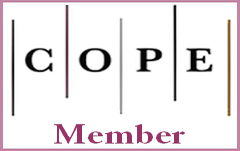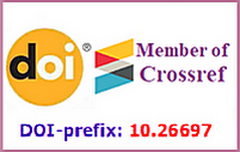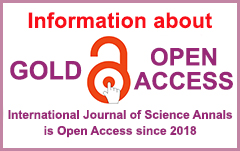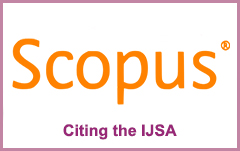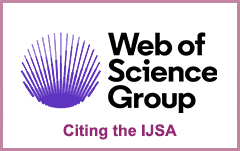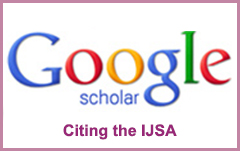Melnyk Y. B. 1,2
| 1 Kharkiv Regional Public Organization “Culture of Health”, Ukraine 2 Scientific Research Institute KRPOCH, Ukraine |
Abstract
Background and Aim of Study: The present study discusses the necessity and sufficiency of the criteria of the Scopus database for quality assurance of scientific publications, as well as the reviewer's role in the journal evaluation process. The paper analyses the process by which Scopus reviewers evaluate IJSA to ensure the Journal meets the stated criteria for indexing in Scopus.
The aim of the study: to investigate the objectivity of the Scopus journal evaluation - to carry out a comparative analysis of the results of the Scopus reviewer evaluation with the real qualitative and quantitative criteria of a particular journal, and to compare them with the criteria of periodicals already indexed in Scopus.
Material and Methods: Qualitative and quantitative IJSA analysis methods based on five categories and fourteen selection criteria from Scopus were used. A comparative analysis of scientific periodicals indexed in Scopus has been conducted. We used open databases to study the current state of the research problem: Scopus website, journals websites, journal articles, and social media.
Results: A case study of a particular journal, IJSA, was used to describe the whole process of preparing, submitting, evaluating, and appealing the evaluation of the Journal in the Scopus database. A journal may indeed meet high criteria for assessing scientific publications, including those declared by Scopus. However, this does not guarantee its indexing in this database because there is a human factor – a Content Selection and Advisory Board (CSAB) reviewer – who has the power to subjectively evaluate the Journal and reject it on formal grounds or his / her misjudgment.
Conclusions: The decision of the CSAB reviewer is more significant for the inclusion of a journal in Scopus than the fulfilment of the quality criteria of the evaluated Journal. This is illustrated by the fact that some journals cannot be indexed or are excluded from indexing in Scopus, while other journals of lesser quality have been indexed in this database for many years. Today's main problems in scientific periodicals are discussed (paper mills, predatory journals, citation cartels, buying an author's place in a commissioned paper, changing journal ownership, fraudulent websites, etc.). A number of criteria for assessing the quality of journals need to be reviewed, and a balance must be struck between their necessity and sufficiency. This eliminates any possible (or forced) manipulation of journals to meet Scopus indexing criteria.
Keywords
Scopus, indexing, evaluation procedure, categories and selection criteria, necessity and sufficiency, journal quality.
References
Abalkina, A. (2021). Detecting a network of hijacked journals by its archive. Scientometrics, 126, 7123–7148. https://doi.org/10.1007/s11192-021-04056-0
Beall, J. (2017). What I learned from predatory publishers. Biochemia Medica, 27(2), 273–278. https://doi.org/10.11613/BM.2017.029
Chaaya, C., Thambi, V. D., Sabuncu, Ö., Abedi, R., Osman, A. O. A., Uwishema, O., & Onyeaka, H. (2022). Ukraine – russia crisis and its impacts on the mental health of Ukrainian young people during the COVID-19 pandemic. Annals of Medicine & Surgery, 79, Article 104033. https://doi.org/10.1016/j.amsu.2022.104033
Chandra, A., & Dasgupta, S. (2024). Predatory journals: What the researchers and authors should know. The American Journal of Medicine, 137(6), 470–472. https://doi.org/10.1016/j.amjmed.2024.02.015
COPE. (2021, February). COPE Member and guest area: International Journal of Science Annals. https://members.publicationethics.org/members/international-journal-science-annals
Demir, S. B. (2018). Predatory journals: Who publishes in them and why? Journal of Informetrics, 12(4), 1296-1311. https://doi.org/10.1016/j.joi.2018.10.008
Dibo, S. (2024). Forced migration and integration challenges of Syrian refugees in Germany: A literature review. The Journal of Social Policy Studies, 22(2), 339–348. https://doi.org/10.17323/727-0634-2024-22-2-339-348
DOAJ. (2020, March 20). International Journal of Science Annals. https://doaj.org/toc/2707-3637
Donovan, S. K. (2013). Death of a small journal? Journal of Scholarly Publishing, 44(3), 289–293. https://doi.org/10.3138/jsp.44.3.007
Editorial Board of the Journal Economic Policy. (2013). Ekonomicheskaya Politika [Economic policy]. https://www.scopus.com/sourceid/21100825345
Elsevier. (2024). Scopus Content Selection and Advisory Board. https://www.elsevier.com/products/scopus/content/content-selection-and-advisory-board
Grudniewicz, A., Moher, D., Cobey, K. D., Bryson, G. L., Cukier, S., Allen, K., Ardern, C., Balcom, L., Barros, T., Berger, M., Ciro, J. B., Cugusi, L., Donaldson, M. R., Egger, M., Graham, I. D., Hodgkinson, M., Khan, K. M., Mabizela, M., Manca, A., Milzow, K., … Lalu, M. M. (2019). Predatory journals: no definition, no defence. Nature, 576(7786), 210–212. https://doi.org/10.1038/d41586-019-03759-y
Immanuel Kant Baltic Federal University. (2018). Baltic region. https://www.scopus.com/sourceid/21100874350
Institute of Economics, the Ural Branch of Russian Academy of Sciences. (2013). Economy of regions. https://www.scopus.com/sourceid/21101137841
Joshi, P. B., & Pandey, M. (2024). Deception through manipulated citations and references as a growing problem in scientific publishing. In Joshi, P.B., Churi, P.P., & Pandey, M. (Eds.), Scientific Publishing Ecosystem (pp. 285-306). Springer . https://doi.org/10.1007/978-981-97-4060-4_17
Kakamad, F. H., Abdalla, B. A., Abdullah, H. O., Omar, S. S., Mohammed, S. H., Ahmed, S. M., ... Najar, K. A. (2024). Lists of predatory journals and publishers: A review for future refinement. European Science Editing, European Science Editing, 50, Article e118119. https://doi.org/10.3897/ese.2024.e118119
Kendall, G., & Teixeira da Silva, J. A. (2024). Risks of abuse of large language models, like ChatGPT, in scientific publishing: Authorship, predatory publishing, and paper mills. Learned Publishing, 37(1), 55–62. https://doi.org/10.1002/leap.1578
Keogh, A. (2020). Beware predatory journals. British Dental Journal, 228(5), 317. https://doi.org/10.1038/s41415-020-1374-4
Kharumnuid, S. A., & Singh Deo, P. (2022). Researchers’ perceptions and awareness of predatory publishing: A survey. Accountability in Research, 31(5), 479–496. https://doi.org/10.1080/08989621.2022.2145470
Macháček, V., & Srholec, M. (2021). Predatory publishing in Scopus: Evidence on cross-country differences. Scientometrics, 126(3), 1897–1921. https://doi.org/10.1007/s11192-020-03852-4
Malvić, T., Andreić, Ž., Barudžija, U., Bedeković, G., Hrnčević, L., Ivšinović, J., Korman, T., Kovač, Z., Pavlić, K., & Pašić, B. (2022). Citation rate challenges for a small journal indexed in Scopus and WoS – Case study from Central Europe (Croatia), editorial view. Publications, 10(3), 32. https://doi.org/10.3390/publications10030032
Melnyk, Yu. B. (2018). Academic journal website model [Preprint]. SRI KRPOCH. https://doi.org/10.26697/Preprint.Melnyk.1.2018
Melnyk, Yu. B., & Pypenko, I. S. (2021). Dilemma: Quality or quantity in scientific periodical publishing. International Journal of Science Annals, 4(2), 5–7. https://doi.org/10.26697/ijsa.2021.2.1
Melnyk, Yu. B., & Pypenko, I. S. (2023). The legitimacy of artificial intelligence and the role of ChatBots in scientific publications. International Journal of Science Annals, 6(1), 5–10. https://doi.org/10.26697/ijsa.2023.1.1
Mertkan, S., Onurkan, A. G., & Suphi, N. (2021). Profile of authors publishing in ‘predatory’ journals and causal factors behind their decision: A systematic review, Research Evaluation, 30(4), 470–483, https://doi.org/10.1093/reseval/rvab032
Mykhaylyshyn, U. B., Stadnik, A. V., Melnyk, Yu. B., Vveinhardt, J., Oliveira, M. S., & Pypenko, I. S. (2024). Psychological stress among university students in wartime: A longitudinal study. International Journal of Science Annals, 7(1), 27–40. https://doi.org/10.26697/ijsa.2024.1.6
National Research University, Higher School of Economics. (2016). Zhurnal issledovanii sotsial’noi politiki [The journal of social policy studies]. https://www.scopus.com/sourceid/11600153627
O'Rorke, R., White, C. & Bhujel, N. (2024). The rise of predatory publishing and journals. British Dental Journal, 237, 699–700. https://doi.org/10.1038/s41415-024-8006-3
Parker, L., Boughton, S., Bero, L., & Byrne, J. A. (2024). Paper mill challenges: past, present, and future. Journal of Clinical Epidemiology, 176, Article 111549. https://doi.org/10.1016/j.jclinepi.2024.111549
Public Opinion Research Center, VCIOM. (2016). Monitoring obshchestvennogo mneniya: ekonomicheskie i sotsialnye peremeny [Monitoring of public opinion: Economic and social changes journal]. https://www.scopus.com/sourceid/21100818507
Pypenko, I. S., Stadnik, A. V., Melnyk, Yu. B., & Mykhaylyshyn, U. B. (2023). The impact of the war in Ukraine on the psychological well-being of students. International Journal of Science Annals, 6(2), 20–31. https://doi.org/10.26697/ijsa.2023.2.2
Rodrigues, R. S., Abadal, E., & De Araújo, B. K. H. (2020). Open access publishers: The new players. PLoS One, 15(6), Article e0233432. https://doi.org/10.1371/journal.pone.0233432
Secchi, D. (2023). A simple model of citation cartels: When self-interest strikes science. In F. Squazzoni (Ed.), Springer Proceedings in Complexity. Advances in Social Simulation (pp. 23–32). Springer. https://doi.org/10.1007/978-3-031-34920-1_3
Shahri, M. A., Jazi, M. D., Borchardt, G., & Dadkhah, M. (2018). Detecting hijacked journals by using classification algorithms. Science and Engineering Ethics, 24, 655–668. https://doi.org/10.1007/s11948-017-9914-2
Singh, C. D. (2021, February 8). Hundreds of “predatory” journals indexed on leading scholarly database. Nature. https://doi.org/10.1038/d41586-021-00239-0
Spears, T. (2014, August 27). Respectable medical journal turns to dark side. Ottawa Citizen. http://ottawacitizen.com/technology/science/respected-medical-journal-turns-to-dark-side
Stadnik, A. V., Melnyk, Yu. B., Babak, S. A., Vashchenko, I. V., & Krut, P. P. (2022). Psychological distress among students and cadets of universities in the war conditions. International Journal of Science Annals, 5(1-2), 20–29. https://doi.org/10.26697/ijsa.2022.1-2.0
Stadnik, A. V., Melnyk, Yu. B., Mykhaylyshyn, U. B., & de Matos, M. G. (2023). Peculiarities of the psychological well-being and social adaptation of young students and cadets in wartime conditions. International Journal of Science Annals, 6(1), 22–30. https://doi.org/10.26697/ijsa.2023.1.7
Teixeira da Silva, J. A., & Al-Khatib, A. (2018). Should authors be requested to suggest peer reviewers? Science and Engineering Ethics, 24(1), 275–285. https://doi.org/10.1007/s11948-016-9842-6
Tomlinson, O. W. (2024). Predatory publishing in medical education: A rapid scoping review. BMC Medical Education, 24, Article 33. https://doi.org/10.1186/s12909-024-05024-x
Melnyk Yuriy Borysovych – https://orcid.org/0000-0002-8527-4638;
| |
APA
Melnyk, Y. B. (2024). How journals are indexed in Scopus and whether this guarantees their quality: A practical case of the International Journal of Science Annals. International Journal of Science Annals, 7(2), 5–26. https://doi.org/10.26697/ijsa.2024.2.3
Harvard
Melnyk, Y. B. "How journals are indexed in Scopus and whether this guarantees their quality: A practical case of the International Journal of Science Annals." International Journal of Science Annals, [online] 7(2), pp. 5–26. viewed 25 December 2024, https://culturehealth.org/ijsa_archive/ijsa.2024.2.3.pdfVancouver
Melnyk Y. B. How journals are indexed in Scopus and whether this guarantees their quality: A practical case of the International Journal of Science Annals. International Journal of Science Annals [Internet]. 2024 [cited 25 December 2024]; 7(2): 5–26. Available from: https://culturehealth.org/ijsa_archive/ijsa.2024.2.3.pdf https://doi.org/10.26697/ijsa.2024.2.3






